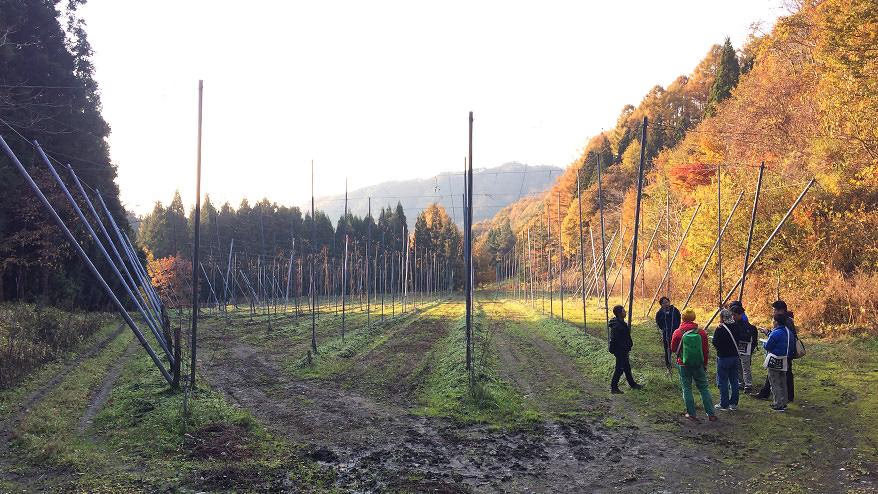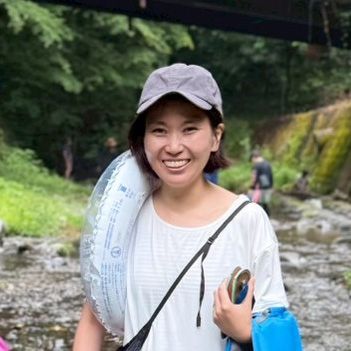Hello. This is Nakaniwa, the editor-in-chief.
For three days from November 4th, we participated in the hackathon " Field Hack TONO ", co-hosted by Google Innovation Tohoku and IAMAS (Institute of Advanced Media Arts and Sciences) .
Field Hack TONO (hereafter referred to as FHT) was a hackathon held in Tono City, Iwate Prefecture, which aimed to use technology to solve problems discovered through fieldwork.
As a hackathon beginner and professional web designer, what did I see and what experiences did I have there?
In the first part, I would like to tell you about the three days we spent in Tono, where we carried out everything from fieldwork to idea development.
(In the second part, we will report on the development of the prototype and its release.)
INDEX
Before that, there will be an information session and team selection.
In this FHT, participants will not jump straight into fieldwork, but will instead begin by finding team members themselves.
You can recruit members from among your circle of friends in advance, or you can find others at the FHT participation information session.
Since I didn't have any teammates, I attended the second information session held in Tokyo alone.
By the way, the theme of the fieldwork is decided in advance.
- Beer Village (Brewing)
- Satoyama (Life)
- Fermentation
- Marginal Villages (Community)
- Shopping district (Tourism)
I chose "Beer Village" from the beginning.
Tono City in Iwate Prefecture is the number one producer of hops in Japan, which is essential for beer. The mission of this project is to enliven the town of Tono with beer and hops, and to think about mechanisms for solving problems.
What first got me interested in this event was the idea that it would be really interesting if I could use my skills to somehow get involved with craft beer, which I've always loved. However, my specialty is website design and direction. This time, the requirement was to use IoT and technology, and I thought that only system engineers and programmers could participate, so I was half anxious and half excited, wondering if there was anything I could do.
Four of the five people who made up the team were there. Two of them had already joined another member, making a team of three. I was a little intimidated because everyone was a hardcore engineer, but they all had such a strong passion for beer that it was fun!
Although I was overwhelmed, I intuitively felt that it would definitely be fun to join this team with these people, so I decided to put aside my concerns about my own skills and accept them as part of the team.
Day 1, kick-off meeting
From Tokyo to Tono, the home of stories
On Friday, November 4th, I drove to Tono with some Monosus colleagues (and former colleagues) from other teams to attend the kickoff meeting starting at 7pm.
Heading north from Tokyo and entering Iwate Prefecture, we got off the highway and were greeted by a beautiful rural mountain landscape.
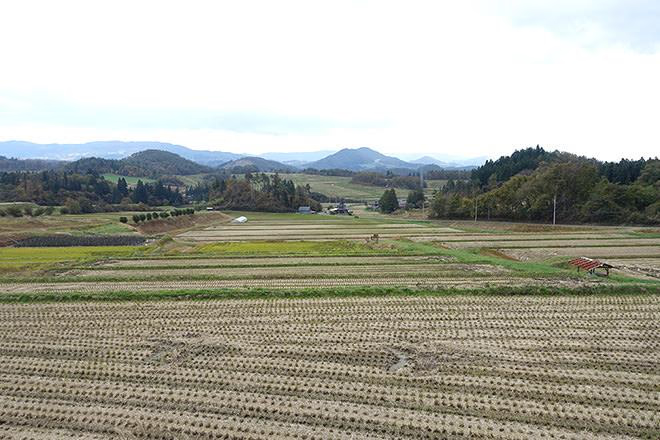
Endless rice fields and mountains, with occasional rivers. As the birthplace of Kunio Yanagita's "The Tales of Tono," the scenery seems as if stories are sleeping everywhere. As I was enjoying the scenery with the theme song of Japanese folk tales, "Boy, go to sleep, you're a good boy," naturally starting to play in my head, I arrived in Tono City in the blink of an eye.
After dropping off our luggage at our accommodation, we set off on the Kamaishi Line for the venue of the hackathon, Tono Mirai College.
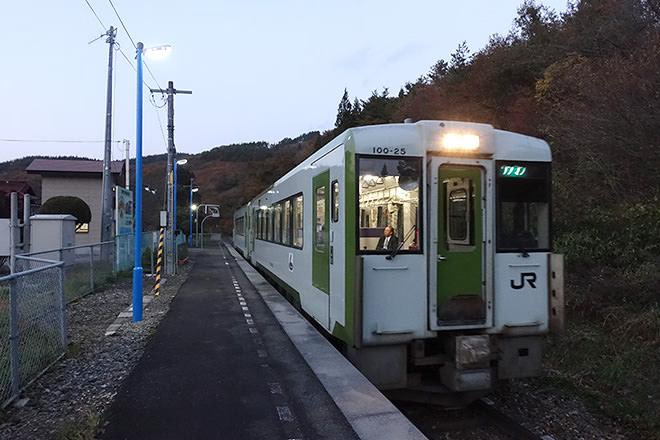
A two-car locomotive runs to Kashiwagi-daira Station on the Kamaishi Line once every 2-3 hours. It's a train you definitely can't afford to miss.

We finally arrived at Tono Station. As you would expect from a city of stories, even the handwritten letters of "Tono Station" exude a certain travelling feeling.
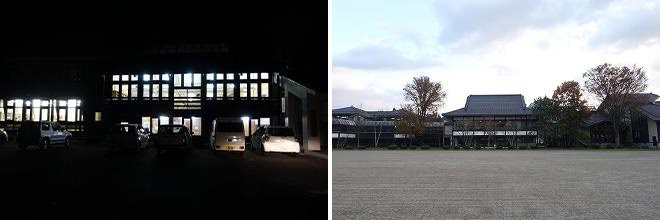
We were taken to the hackathon venue, Tono Mirai College, by car. On the right is a picture of Mirai College taken during the day.
First, the project owner will give an overview of the program, followed by a moment for self-introductions.
We had an introduction of the organizers and management members, the staff at Next Commons Lab (hereafter referred to as NCL) who will be supporting this hackathon from the Tono city side, the Tono Big Brothers and Big Sisters who will be guiding us during the fieldwork, and finally the participants introduced themselves in groups of teams.
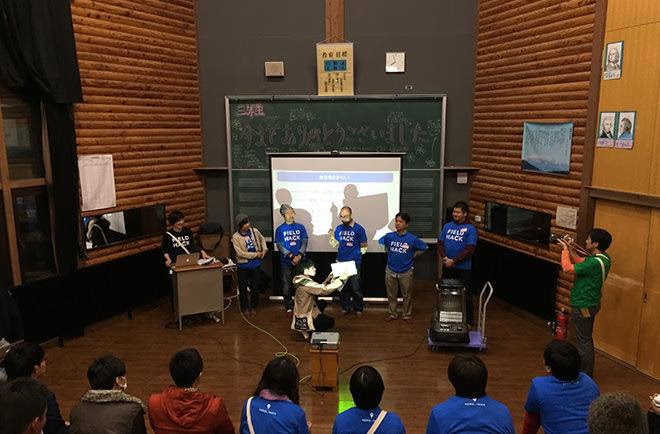
The five members of our Beer Village team, or "Team Humulpu," introduce themselves. "Humulupu" is an abbreviation of the scientific name for hops, Humulus lupulus (the abbreviation is not official).
After that, we had dinner, which we called a breakout session. Thanks to the food and beer brought by our enthusiastic teammates, our team had turned into a luxurious banquet table.
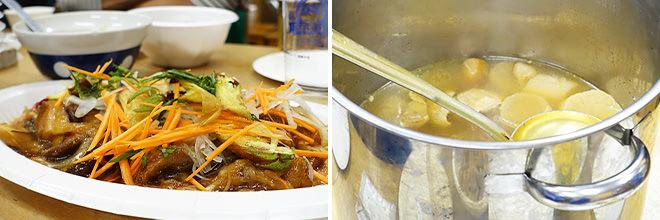
Juicy, meaty shiitake mushrooms and okra in thick sauce (left) and oden (right)
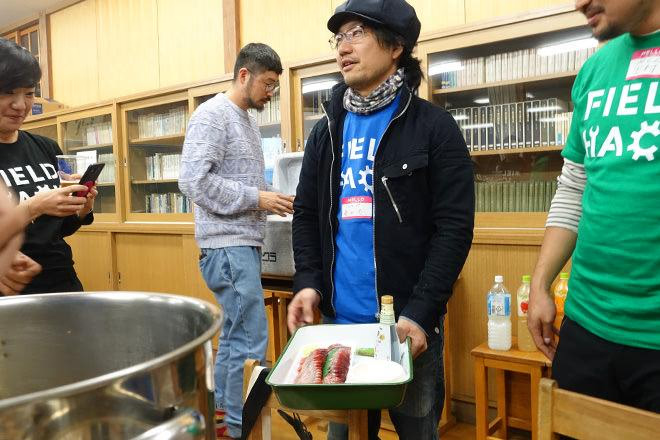
Suddenly, a member from Kesennuma brought in some freshly caught bonito.

Sashimi of bonito caught in Kesennuma (left), and craft beer brought by a member (right)
It was here that I met for the first time our team's Tono Nii-san*, also known as hop farmer Yoshida-san, Tamura-san from NCL, and Hiramatsu-san, who started farming hops this year. Before the fieldwork began, we had the chance to talk to them about various things, including hop cultivation.
Anticipation for tomorrow's fieldwork is growing.
* Who are Tono Big Brothers and Big Sisters? They are local collaborators who guide us during fieldwork. They come for each theme.
Just as the conversation was getting lively, the discussion time (dinner) ended in a flash.
You can rest up for the next day, or if the fieldwork is at night, some teams may go out to an after-party.
It seems they each had their own night.
Day 2, Fieldwork
Walk with your feet, hear with your ears, see with your eyes, and touch with your hands.
Anyway, input
Outline of the second day
14:00 ~ 17:30 Fieldwork
17:30 ~ 19:00 Fieldwork analysis
19:00 ~ 21:00 Social gathering
21:00 ~ Move to your cottage
Finally, the day of the field hack has arrived. Starting at 2pm, we will spend about three hours touring the fields of Tono with the Tono Brothers and Sisters, focusing on each theme.
Our beer team will be conducting fieldwork at three locations: a hop farm, a hop drying facility, and a brewery.
First of all, we went to a hop farm! Tono-nii-san, also known as Yoshida-san, took us to Asahi Farm.

Atsushi Yoshida, manager of Asahi Farm at Tono Niisan
Yoshida told me that it takes at least three years for newly planted hop plants to produce abundant hop fruit, that the vines grow very tall, that agricultural machinery is hard to come by in Japan so they have to manage to find second-hand equipment overseas (if it breaks there is no replacement), that farmers work in teams to harvest hops in groups, taking turns, so they cannot always harvest the hops from their own fields at the right time, etc.
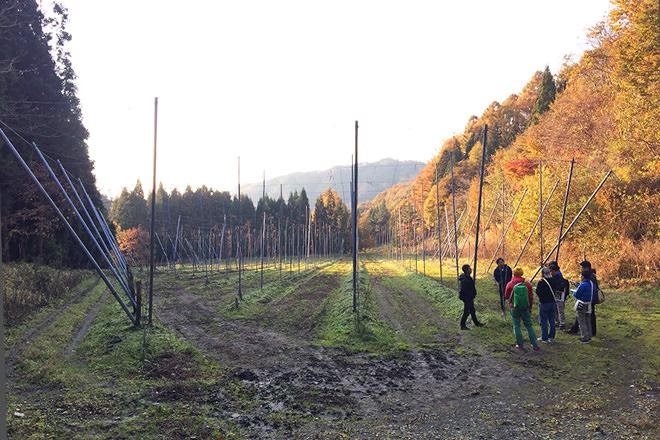
Field work in a hop field after the harvest. At first glance it looks deserted, but the hop stalks are still sleeping in the soil. I'd like to return during the hop harvest.
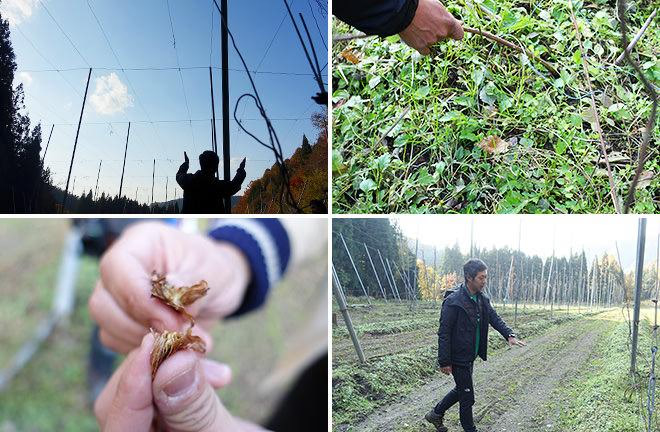
The harvest ends in September, so when we visited in November, there were no vines, just a number of tall supports (top left). In the piled-up soil, you can see the hops that will sprout next year (top right). We weren't able to see any fresh hops, but we did pick up some hops that had fallen to the field and dried naturally, and we were able to crack them open and smell the hop aroma (bottom left).
One thing that struck me the most was that the evaluation of the hops produced does not reach the hop farmers.
Because most of the hops grown in Tono are shipped to major beer manufacturers, it is difficult to receive evaluations for the hops you grow on their own, and there are few opportunities to receive feedback from brewers.
In addition, the content of alpha acids, which is a key factor in evaluating hop quality, is currently difficult for individual farmers to measure and record.
Afterwards, we had the opportunity to tour the hop drying facility, which had been in operation until this year but is now planning to close. The factory, lined with old, large machines, looks like it could still be in operation for a while. Still, the reason for closing it down could be that hop production has fallen to a quarter of its peak. I think the problem of a lack of successors to hop farmers is also behind it.
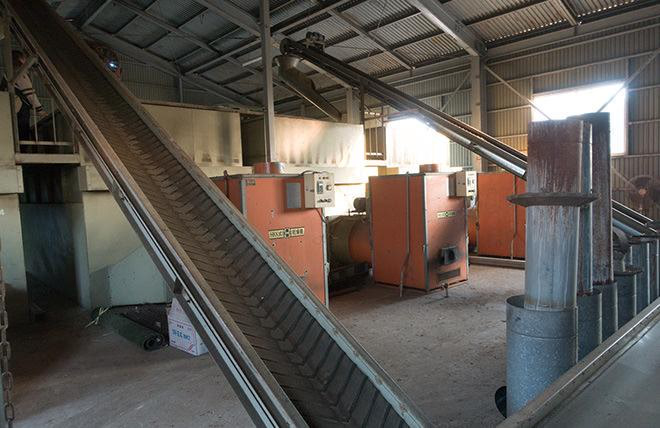
Inside the hop drying factory of the Sawada Hop Producers Association, part of the Special Measures for Promoting Agricultural Land Use
Finally, we spoke with Mr. Tsuboi of Kamihei Sake Brewery, which brews Tono's only craft beer, ZUMONA .
Tsuboi-san is in charge of all the brewing process of ZUMONA beer, managing the factory, and even product development all by himself, and even as an amateur, I can imagine that the work is endless. When I asked him what the most difficult part was, he answered, "Maintaining the equipment," which was impressive.
And surprisingly, there is only one store in the local area of Tono that sells "ZUMONA" by the keg! Although more and more stores where you can drink craft beer are opening in urban areas, there are almost none in Tono, and it seems that nationwide, awareness of beers other than those from the major beers is still low.

Tsuboi (left), a brewer who makes ZUMONA beer at Kamihei Brewery. Inside the brewery, there are rows of large tanks (right).
Fieldwork analysis
Analyze the latest information while it's still fresh
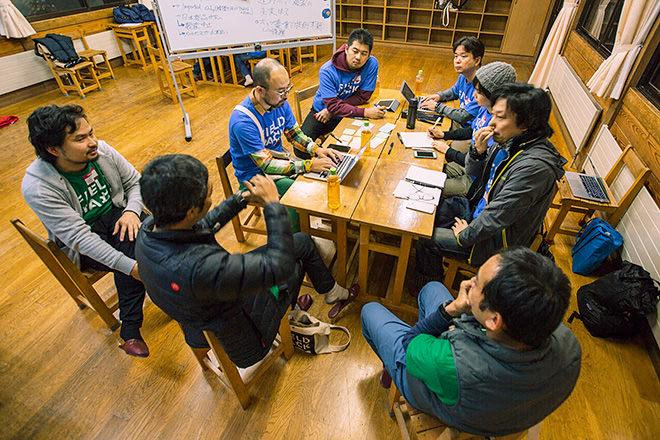
Each team had a discussion in their own classroom. Tono-nii-san and NCL-san also participated in the first half, and the second half was a discussion just for the team.
The information that we have gleaned from our three hours of fieldwork should be put on the chopping block while it is still fresh. Then it was time to analyze the fieldwork.
Each team moves to a discussion room (classroom) and shares, organizes, and analyzes what they discovered today. The analysis method that Professor Kobayashi taught us there is to
- Who
- Trigger + Action
- How
- why
- Emotions etc.
The idea is to break it down into parts and write each part on a post-it note. This allows you to think about the approach from various perspectives. For example, by rearranging "3. How" with other parts, you can consider and verify methodologies that you had not noticed before.
So, our team tried to write things down on Post-it notes using the framework we were taught, but it just didn't work out...
We received a great deal of information this time, and we decided on the spot that if we continued like this we would not be able to finish within the time limit, so we decided to first make a list of our findings.
Once most of the information was ready, we divided up the items and began the work of breaking them down into 1 to 5 above.

Before we knew it, the analysis time was over. Our team ended up leaving the classroom without finishing.
In the evening, enjoy a social gathering.
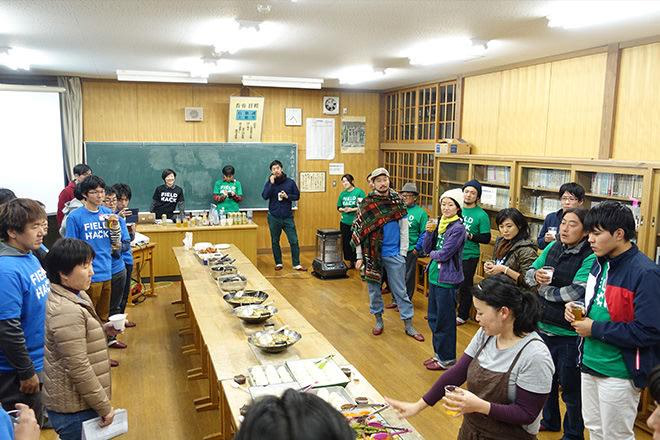
Although I was a little worried that the analysis was not completed, it was time for dinner and the social gathering, which I was looking forward to.
Just like last night, the food was prepared by Mr. Fujita and others from NCL.

Mr. Fujita of NCL explaining the menu
The menu served at the table was all carefully prepared by the chef, using mainly local Tono ingredients.
The Marginal Villages team also brought in some miso, which they had received from people in the town during their fieldwork, making it a heartwarming meal.
Unlike the previous day, this day was a buffet style event. It was a chance to talk candidly with Tono-nii-san and NCL-san about the continuation of the fieldwork, and to interact with other teams.
Day 3: After input, it's time for output
Creating concepts from idea sketches
Outline of the third day
9:00 ~ 9:35 Introduction & Product Introduction
9:35 ~ 11:50 Idea sketch & concept creation
11:50 ~ 12:50 Lunchtime
12:50 ~ 13:50 Preparation for presentation
13:50 ~ 14:50 Presentation and Commentary
15:00 ~ 15:30 Meeting with Tono-san and coordinator
15:30 ~ 15:45 Explanation of future plans (development / presentation and consultation)
15:45 ~ Disband!
Last night, many of the team members seemed to have a good time talking and drinking in the cottage where they were staying, but the next morning they left at 8:00. Since there was no place to eat nearby, they had a hot breakfast prepared by NCL early in the morning.
After getting energized with breakfast, the hackathon began, continuing from yesterday.
First, there was an explanation of today's work. We were shown the product that would serve as a reference for development, and we were given an explanation of everything from idea sketches to concept sketches.
This time was not just a simple explanation. All the talks expanded the possibilities for ideas and development. It was truly an eye-opening experience, as it was the culmination of the wisdom and experience of people with a deep knowledge of technology.
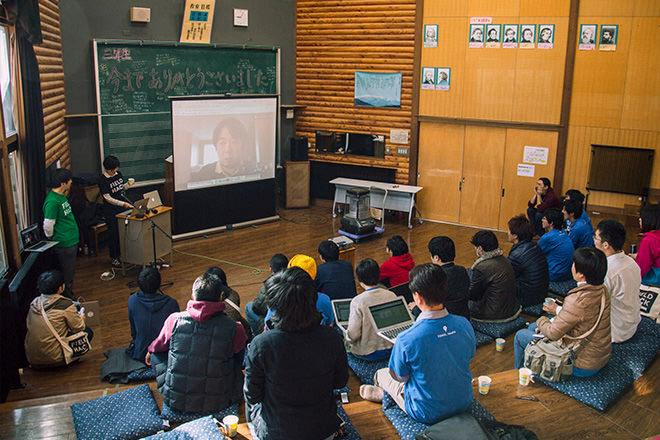
One of our technical mentors, Kazunori Sato from Google, will be explaining the product to us via Hangouts from the US.
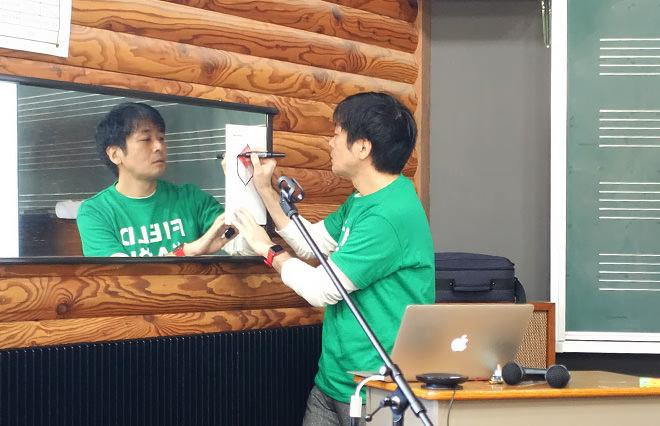
Technical mentor Shigeru Kobayashi (IAMAS professor) explains the idea sketches and demonstrates them.
After the briefing, we decide on the assignment before moving on to sketching ideas.
As a team, we think about the challenges we need to tackle by asking ourselves, "What should we do to achieve this?"
So, based on yesterday's fieldwork and analysis,
"How can we facilitate the flow of information about hops?"
It was concentrated into the following issue.
How can we pass on feedback from brewers and consumers to Mr. Yoshida, a hop farmer who has almost no opportunity to learn about the evaluation of hop quality? Or how can we get the voices of consumers to reach brewers directly?
For this assignment, we started to individually sketch ideas. Our team did two sets of 10 minutes of sketching time and 10 minutes of idea sharing time.
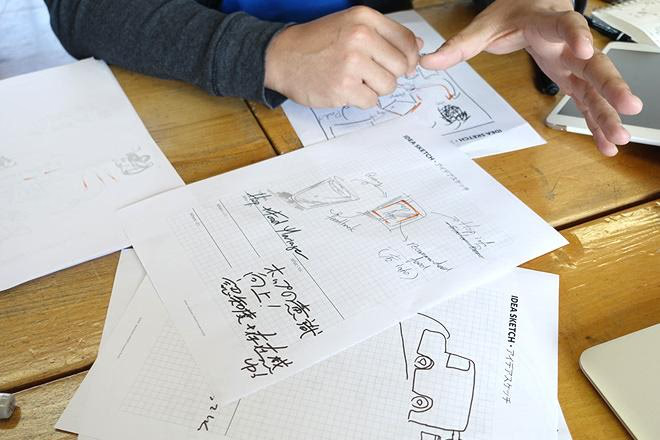
No one could stop writing. The number of idea sketches just kept increasing.
The ideas that came out were really unique. Nearly 40 to 50 pages were created on the idea sheet, including a hop cultivation set, a Pokemon-like game where you walk around town to get beer, and a service where you can deliver beer with the push of a button, like the beer girls at baseball stadiums, carrying a ZUMONA server on your back.
Some of the ideas that came up were similar, so I decided to group them together in a series.
The ideas were divided into six categories: "Information dissemination," "Interaction," "Alpha acids/chemistry," "Cultural education," "Farming," and "Other."
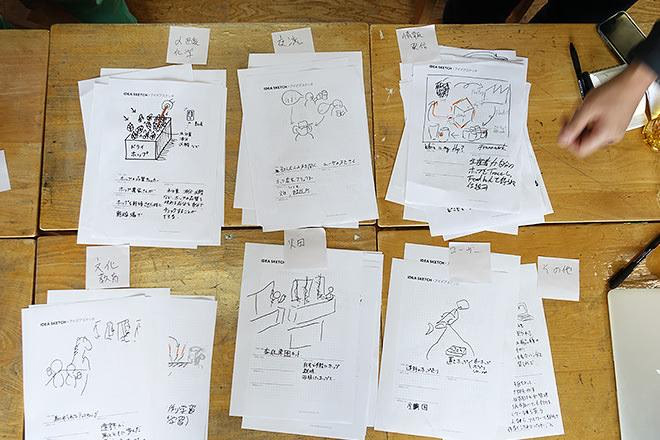
From these, we first eliminate those that are not feasible, and then those that do not use technology.
In this way, we narrowed down the ideas to nine. We decided to evaluate each of them based on a set of criteria, and decided to assign scores to each of them. We also immediately compiled these in a spreadsheet.
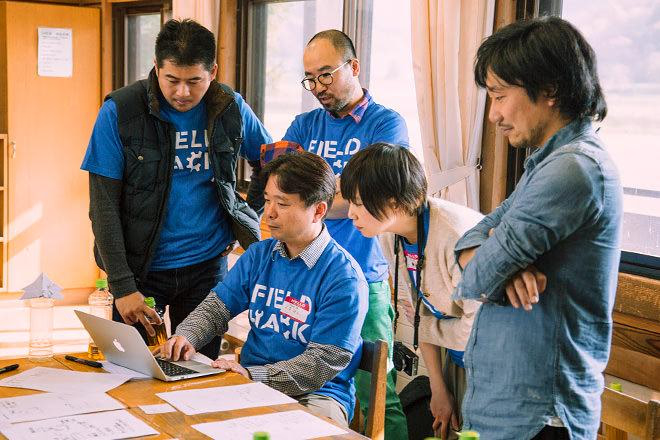
Discuss while everyone looks at the screen summarizing the spreadsheet
These results are not absolute, but merely a reference. We will use these results as a reference to decide through discussion what ideas to present.
At this point I have two ideas left.
- Vialog
- VR Bar
Beerlog is like a beer version of Tabelog. It is an app that logs the ratings and reviews of the beers users have drunk, analyzes the accumulation of numbers (quantitative evaluation) and words (qualitative evaluation), and calculates the evaluation of the beer and the hops associated with it.
This was conceived as a way to provide Yoshida with feedback from users and brewers, as he wanted to receive evaluations of the hops he made.
Another project is the VR Bar, which will be set up outside of Tono, where scenes from Tono's hop farms will be projected onto walls and other surfaces using projection mapping, allowing people to communicate with each other not only through video chat but also by adding interactive effects to the images.
It is a system that connects Tono with places outside of Tono (such as beer pubs in Tokyo), beer makers and beer drinkers.
While discussing the feasibility and advantages of each idea, we came to the conclusion that it might not be a good idea to narrow it down to one before even hearing Yoshida's opinion, so we ended up presenting both ideas.
Ideathon from Field Hack,
The announcement is finally here
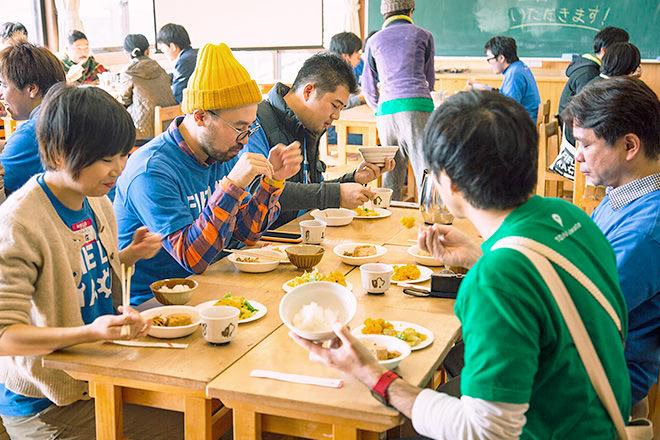
Following breakfast, we had lunch prepared by NCL.
We took a break and ate the lunch prepared by NCL. We finished eating at around 1pm, but the presentation was scheduled for 2pm. There was not much time to put together the materials!
I was feeling nervous and trying to suppress my impatience, but my teammates seemed to be more relaxed.
With only about 20 minutes left, there was an idea to mix in some skits during the presentation, but in the end we decided to just summarize our ideas on slides.
From there, things moved at full speed. We divided up the ideas for the beer log and the VR bar and started creating materials.
Creating the slides took up a little bit of my presentation time, but I managed to complete it.
We were the fourth team to present out of a total of five teams.
The presentation time was 5 minutes. Each team put together a good summary in that short time.
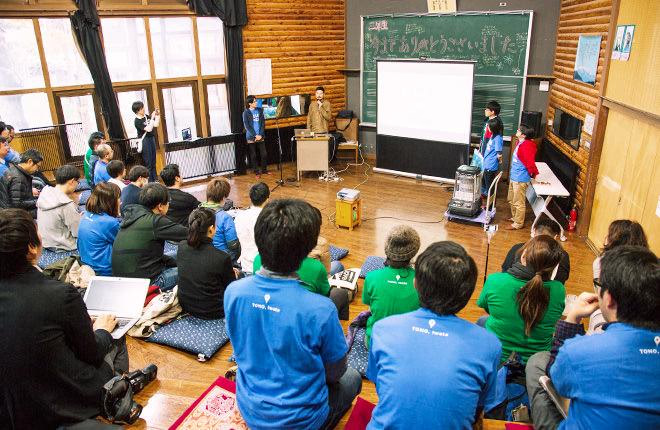
The Satoyama team's presentation. Everyone was listening intently to the presentations by teams other than their own.
We were rushed because we only presented two ideas, but our teammates Kumaken and Mizu's presentation skills were so good that it made me wonder if they had been practicing since yesterday, and we were able to finish our presentations without any problems.
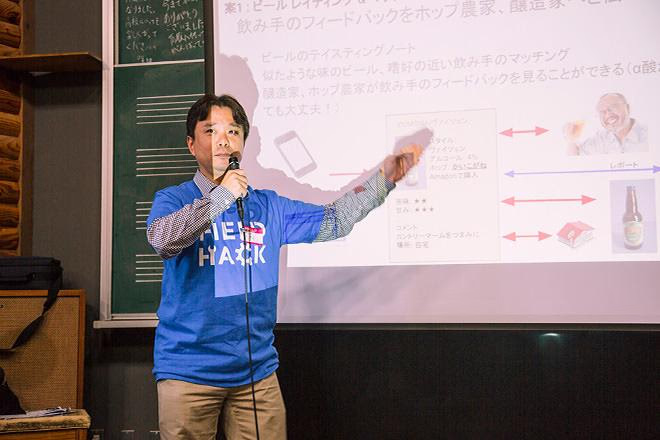
Kumaken giving a smooth presentation
From there, it was time for consultation with Tono-nii-san. Team Humulup explained to Yoshida-san again, including the parts that they were unable to convey in their presentation, and received feedback.
Meanwhile, Kumaken seemed to be typing something on his computer, and then suddenly held the screen out into the circle.
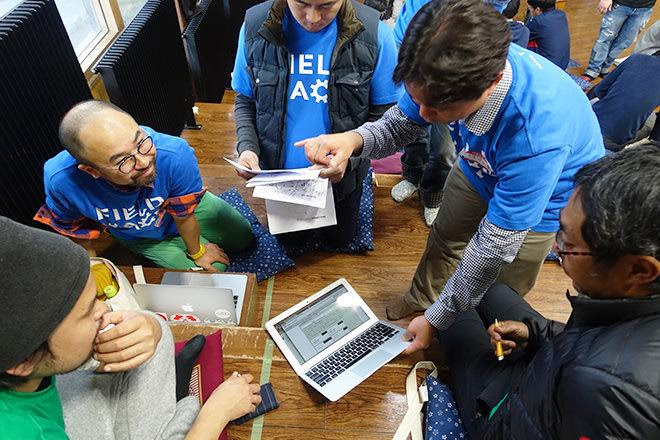
Using Google's API ( CLOUD NATURAL LANGUAGE API ), they prepared a rough summary table of comments related to the evaluation of ZUMONA beer from online articles that mention ZUMONA beer.
Everyone was curious about the screen. Could this be used to perform natural language analysis of words related to beer and hops? And it's amazing how it can be displayed instantly!
This live feeling is electrifying.
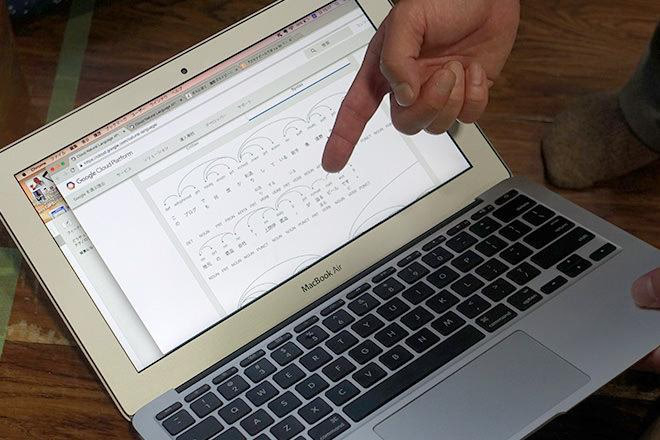
As a result of this immersive discussion, we decided to keep the idea of a VR bar, but create a beer log app as a prototype.
Thus came to a close the three-day field hack, which was also my first trip to Tono.
Before there was any time to enjoy the afterglow, the curtain rose on the turbulent development phase.
"Field Hack TONO Development - Announcement" will be posted in the second part. Please look forward to the update soon.
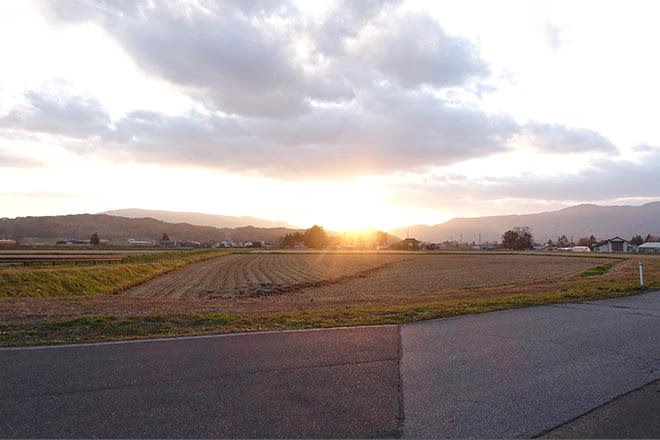
Rice fields in Tono at sunset
